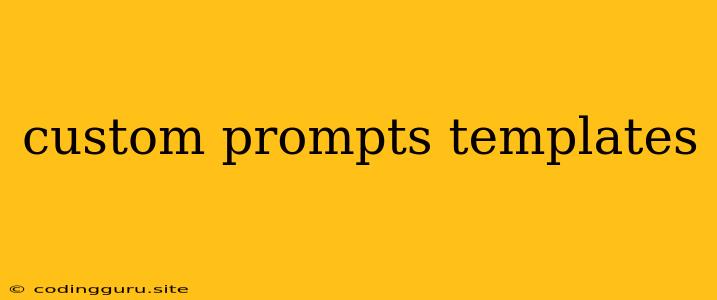Crafting the Perfect Prompt: A Guide to Custom Prompts and Templates
In the world of large language models (LLMs), the power of prompts is undeniable. These carefully crafted instructions guide the AI to generate the desired output, whether it's a creative story, a factual summary, or a technical code snippet. But what if you could elevate your prompts beyond basic instructions and into a realm of tailored precision? This is where custom prompts and templates come in.
Imagine a world where your LLM understands your specific needs without you having to repeat the same instructions every time. This is the promise of custom prompts and templates, allowing you to create a structured framework that ensures consistent and efficient interaction with your AI companion.
Why Use Custom Prompts and Templates?
Think of it like a recipe for a delicious dish. You can follow a general recipe for cookies, but for the ultimate culinary experience, you might create your own recipe with specific ingredients and instructions. The same applies to prompts. Custom prompts and templates allow you to:
- Standardize your requests: Ensure consistent output by defining a specific format for your prompts.
- Streamline your workflow: Save time and effort by eliminating the need to repeat the same instructions.
- Improve accuracy: Guide the LLM towards the desired results with specific guidelines and parameters.
- Fine-tune your AI's responses: Generate output that aligns perfectly with your unique needs and preferences.
- Unlock new possibilities: Experiment with different formats and structures to discover new creative and technical applications.
Building Your Custom Prompts and Templates
Creating effective custom prompts and templates requires a structured approach. Here's a breakdown of the key steps:
- Identify Your Needs: What specific type of output are you looking for? What are the essential components you need to include in your prompt?
- Define Your Parameters: Determine the key variables that will influence the LLM's response. These could be things like the desired tone, length, style, or specific information to include.
- Craft Your Template: Start with a basic structure that includes placeholders for the variables you've defined.
- Populate with Examples: Use real-world examples to demonstrate how your template should be used.
- Test and Refine: Experiment with different variations of your template and adjust it based on the results.
Examples of Custom Prompts and Templates
Here are some examples of how you can use custom prompts and templates in different contexts:
1. Content Creation:
- Template: "Write a [type of content] about [topic] in a [tone] style. The content should be [length] words long and include these keywords: [keywords]."
- Example: "Write a blog post about the benefits of meditation in a calm and informative style. The content should be 500 words long and include these keywords: mindfulness, stress reduction, focus."
2. Code Generation:
- Template: "Generate a [programming language] code snippet for a [functionality]. The code should be [complexity] and include the following parameters: [parameters]."
- Example: "Generate a Python code snippet for a function that calculates the factorial of a number. The code should be beginner-friendly and include the following parameters: number."
3. Creative Writing:
- Template: "Write a [genre] story about [characters] in [setting]. The story should be [length] words long and include the following elements: [elements]."
- Example: "Write a fantasy story about a brave knight and a magical dragon in a mystical forest. The story should be 1000 words long and include the following elements: sword fight, ancient prophecy, hidden treasure."
Unlocking the Power of Custom Prompts
Custom prompts and templates are not just a technical tool; they are a powerful way to unlock the full potential of LLMs. By creating a structured framework for interaction, you can guide the AI to generate output that is tailored to your specific needs and preferences. Experiment with different formats, refine your templates, and watch as your LLM becomes an even more powerful ally in your creative and technical endeavors.
Conclusion
Custom prompts and templates are a valuable tool for anyone working with LLMs. By taking the time to define your needs, create a structured framework, and refine your approach, you can unlock new levels of precision, efficiency, and creativity in your interactions with AI. So, embrace the power of custom prompts and start crafting the perfect prompts for your unique needs. The possibilities are endless!
